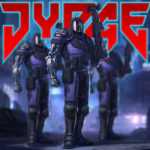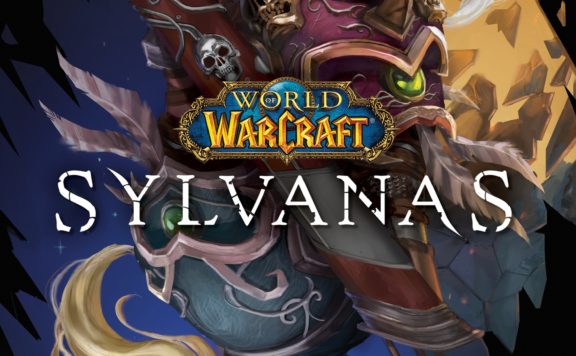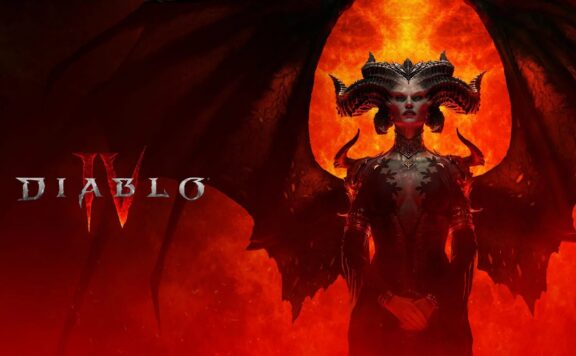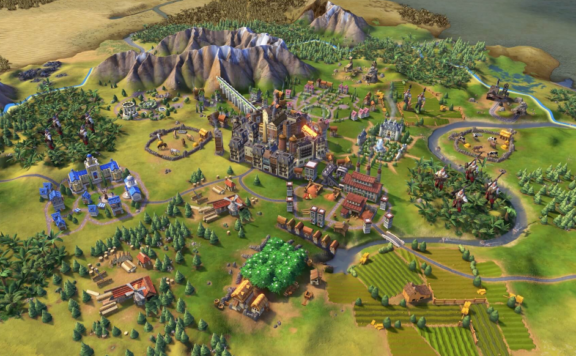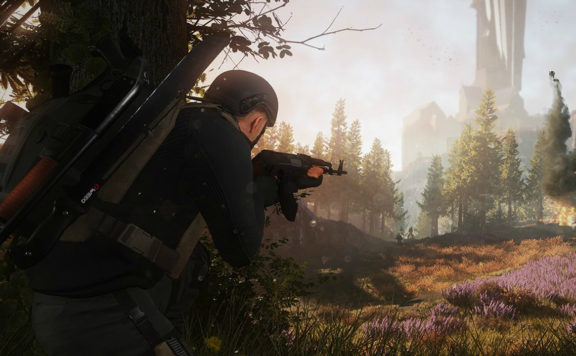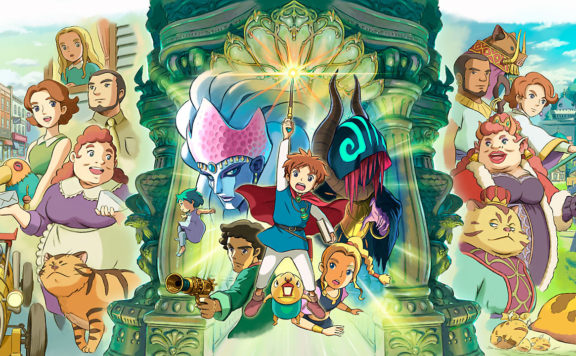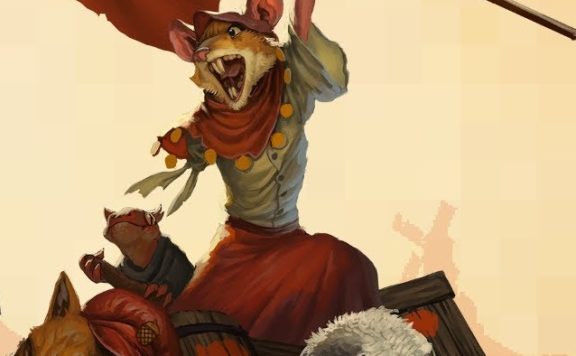There’s something I find special about modern twin-stick shooters, and the dance with death as you deftly dive between bullets. It captivates me in a way, unlike most other genres. Maybe it’s the nostalgia I feel for like games I played in the arcades as a young boy, or perhaps it’s the neon-light depicted bullets I can’t help but be entranced by. Whichever the case, JYDGE hits all these and more, meshing twin-stick mechanics with rogue-lite tendencies and a dash of RPG for flavor. From the studio 10tons Ltd., the makers behind Neon Chrome and Crimsonland, comes JYDGE: a new top-down twin-stick styled shooter. This is our JYDGE review.
When I first started the game, I was given a brief cutscene that introduced me to the violence and strife that is rampant in the world of JYDGE. For some reason not explained, the letter U seems to be the main culprit and society has gone out of its way to replace it in every word that it’s present: jydge, jystice, shotgyn, byllets, etc. What’s more, robots seemed to have taken over the world, finally. Not only is your JYDGE a cold, metallic thug-killing machine but the voiceover work is also programmed electronically. Kudos to 10tons for their work in programming inflection, tone, and timbre into the voicework present in the game. A part of me wonders if this was in any part a result of the recent video game voice actor strike; but I really liked the robotic voices, as it fits the overall theme of the game, giving it even more of a futuristic sci-fi quality. I would’ve preferred more voiceovers in the game due to the quality the studio exhibited here in this aspect.
 The game has a definite Neon Chrome feel – neon lights, isometric POV, quick replayable missions, twin-stick mechanics, upgradable aspects. So much so that it’s incredibly difficult to not compare the two. There are also destructible elements in every mission, similar but more so than Neon Chrome. You can shoot down downs, clear tables and chairs, or even blast your way through the walls! This added a level of choice to each mission that really made it feel more dynamic. The soundtrack also has a dynamic, yet eclectic range, that changed tracks every time I started or restarted a mission. From techno to 8-bit video-game sounds, to rock to sick fat beats: the music was groovy and worked great as background music, but got repetitive after a while of listening to it throughout the missions. The structure of the game is told in four Acts and has a total of 18 missions.
The game has a definite Neon Chrome feel – neon lights, isometric POV, quick replayable missions, twin-stick mechanics, upgradable aspects. So much so that it’s incredibly difficult to not compare the two. There are also destructible elements in every mission, similar but more so than Neon Chrome. You can shoot down downs, clear tables and chairs, or even blast your way through the walls! This added a level of choice to each mission that really made it feel more dynamic. The soundtrack also has a dynamic, yet eclectic range, that changed tracks every time I started or restarted a mission. From techno to 8-bit video-game sounds, to rock to sick fat beats: the music was groovy and worked great as background music, but got repetitive after a while of listening to it throughout the missions. The structure of the game is told in four Acts and has a total of 18 missions.
Each mission starts with three objectives, with one being the primary goal before you can move on. These objectives range from saving hostages to killing specific enemies and even beating the level in as little as 15 seconds. Some objectives can be daunting; but they can all be easily overcome with enough planning and strategy, as well as outfitting your JYDGE with the right equipment. To show progress, each successfully completed mission objective unlocks a medal. You’ll need these medals to unlock the next mission as you advance through the game. But these medals are also needed to unlock mods and augments for your JYDGE. After Act 1, you unlock Hardcore difficulty on missions as well. These add yet another three different objectives to fulfill, as well as increase the number of enemies in the mission and the placement of objectives. Your gun, the ‘Gavel’ appropriately enough (it even has the two hammer sides of a judge’s gavel on the front of the barrel), can also be upgraded and modded. There are over 35 upgrades to your JYDGE, of which you can equip 4 at a time. 15 special secondary ammo for your Gavel, ranging from Rockets to Grenades to Ion balls of electrical death. 25 Gavel mods, which you can have three equipped. And 14 fire modes for your Gavel, so you can switch between lead byllets to laser beams to plasma to, my favorite, the shotgyn. 10tons Ltd claims there are over a billion unique setups available but, sadly, I did not have time to test them all out.
 There were a few initially confusing aspects of this game, however; and I must say it did not do a great job of explaining aspects like mods and cyberware. A lot of the upgrades I had to test out before I understood precisely what I could use them for: for example, the Riot Shield cyberware allows me to take 200 damage from the front before it broke and it affected my health – this was invaluable on missions that required me to not take any damage as an objective. It’s not that I wanted everything in the game overly simplified, I would have just preferred better descriptions than, “blocks all frontal damage up to 200HP.” Other problematic things are minor, but add up to a feeling of less than quality standards that I expect from 10tons. The character screen, in particular, is designed like a blueprint that has squares to click and add cyberware – my main issue is with the way the JYDGE’s outline looks: at first I thought it was a pharaoh and I thought, “Oh, that’s weird. I wonder why I’m a pharaoh.” It took me much too long (about two hours of playing) to finally realize, “That’s not a pharaoh’s head-dress, that’s a judge’s wig!” and I could hear the audible ‘click’ in my mind as it finally made sense to me.
There were a few initially confusing aspects of this game, however; and I must say it did not do a great job of explaining aspects like mods and cyberware. A lot of the upgrades I had to test out before I understood precisely what I could use them for: for example, the Riot Shield cyberware allows me to take 200 damage from the front before it broke and it affected my health – this was invaluable on missions that required me to not take any damage as an objective. It’s not that I wanted everything in the game overly simplified, I would have just preferred better descriptions than, “blocks all frontal damage up to 200HP.” Other problematic things are minor, but add up to a feeling of less than quality standards that I expect from 10tons. The character screen, in particular, is designed like a blueprint that has squares to click and add cyberware – my main issue is with the way the JYDGE’s outline looks: at first I thought it was a pharaoh and I thought, “Oh, that’s weird. I wonder why I’m a pharaoh.” It took me much too long (about two hours of playing) to finally realize, “That’s not a pharaoh’s head-dress, that’s a judge’s wig!” and I could hear the audible ‘click’ in my mind as it finally made sense to me.
Aspects such as these just distract from the overall feeling and aesthetic of the game and they’re littered all over. Some menus are aesthetically pleasing, even showing a slight projected look to it as it rotates – other menus, however, like the character screen just look cheaply drawn up, as if it was rushed out the door. These are all minor infractions, like I said; but combined it often broke the experience for me as I was taken out of the gameplay loop and just confused what my character did to have any relation to ancient Egypt. An addition to the game that also feels tacked on are the 15 collectibles you can find throughout different missions. There are riddle-like hints that lead you in the right direction but it was more frustrating than fun to track these down. That said, I do like how each collectible adds an aspect to the game that can assist in certain scenarios. For example, on sneaky missions where my objective is to not get seen I like to activate the ‘Seashell’ collectible that lets me see a ghost of my previous run.
 Overall, the comparisons to Neon Chrome are staggering and this game almost seems like an alternative gameplay mode for the same game than it does a completely different one. A lot of assets were obviously re-used, but that’s not necessarily a bad thing. They are both great games in different ways. I much prefer JYDGE more for both its quick mission structure and goal-oriented objectives than I did Neon Chrome’s rogue-like dungeon-running structure. JYDGE also had a more exciting setting and timeline, but maybe that’s just because I’ve always been a fan of Judge Dredd and this was a taste of being like him. I also liked the interchangeable upgrades and perks over Neon Chrome’s progressive passive upgrade system and randomized perks. It’s hard not to compare the two, especially when it’s made by the same developer. But overall, I would recommend JYDGE (and Neon Chrome) to anyone that wants a good, small twin-stick shooter experience. JYDGE is available on PlayStation 4, Xbox One, PC, and will be coming soon to the Nintendo Switch.
Overall, the comparisons to Neon Chrome are staggering and this game almost seems like an alternative gameplay mode for the same game than it does a completely different one. A lot of assets were obviously re-used, but that’s not necessarily a bad thing. They are both great games in different ways. I much prefer JYDGE more for both its quick mission structure and goal-oriented objectives than I did Neon Chrome’s rogue-like dungeon-running structure. JYDGE also had a more exciting setting and timeline, but maybe that’s just because I’ve always been a fan of Judge Dredd and this was a taste of being like him. I also liked the interchangeable upgrades and perks over Neon Chrome’s progressive passive upgrade system and randomized perks. It’s hard not to compare the two, especially when it’s made by the same developer. But overall, I would recommend JYDGE (and Neon Chrome) to anyone that wants a good, small twin-stick shooter experience. JYDGE is available on PlayStation 4, Xbox One, PC, and will be coming soon to the Nintendo Switch.
Note: Our copy was reviewed on PC with a code provided by PR.

